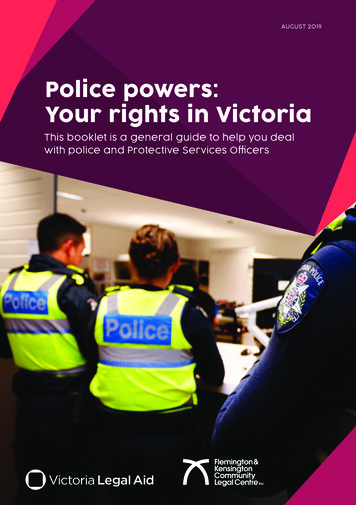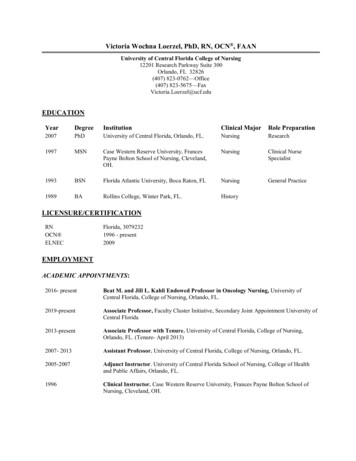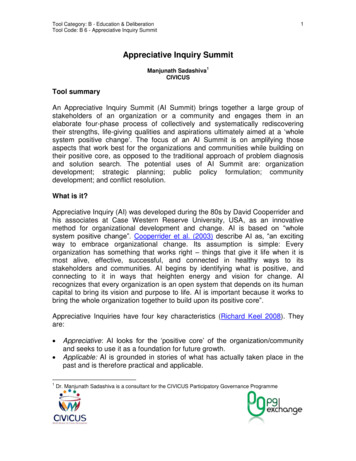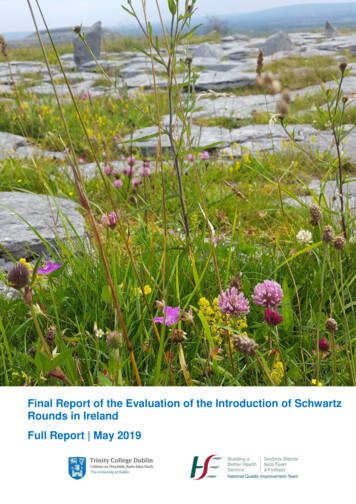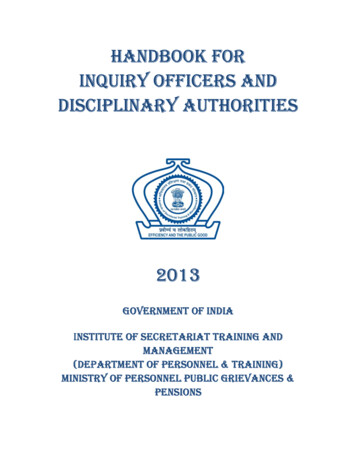
Transcription
THEVICTORIA CLIMBIÉINQUIRYChairman: Lord LamingREPORT
THE VICTORIA CLIMBIÉ INQUIRYREPORT OF AN INQUIRYBY LORD LAMINGPresented to Parliament by theSecretary of State for Health andthe Secretary of State for the Home Departmentby Command of Her MajestyJanuary 2003CM 5730
Crown Copyright 2003The text in this document (excluding the Royal Arms) may be reproduced freeof charge in any format or medium provided that it is reproduced accurately andnot used in a misleading context. The material must be acknowledged as CrownCopyright and the title of the document specified.Any enquiries relating to the copyright in this document should be addressed to TheLicensing Division, HMSO, St Clements House, 2-16 Colegate, Norwich NR3 1BQ.Fax: 01603-723000 or email: licensing@cabinet-office.x.gsi.gov.uk
Rt Hon Alan Milburn MPSecretary of State for HealthRt Hon David Blunkett MPHome SecretaryDear Secretaries of State,In April 2001, you asked me to chair an Independent Statutory Inquiry followingthe death of Victoria Climbié, and to make recommendations as to how such anevent may, as far as possible, be avoided in the future. I am pleased to submit myreport to you.I appointed four expert assessors to assist me in my task. They were Dr NellieAdjaye, Mr John Fox, Mrs Donna Kinnair and Mr Nigel Richardson.I take responsibility for this report and I am pleased that my four colleagues whosat with me fully endorse its findings and its recommendations.Yours sincerely,LORD LAMINGDR NELLIE ADJAYEMR JOHN FOXMRS DONNA KINNAIRMR NIGEL RICHARDSON
“I have suffered too much grief in setting downthese heartrending memories. If I try to describe him,it is to make sure that I shall not forget him.”Jiro Hirabayashi from Yasunori Kawahara’stranslation of The Little Prince by Antoine de Saint-Exupéry.This sentiment applies also to Victoria Climbié.This Report is dedicated to her memory.
The Victoria Climbié Inquiry
ContentsContentsPart one123BackgroundIntroductionThe InquiryVictoria’s story11525Phase OnePart twoSocial services4Ealing Social ServicesThe managerial contextVictoria in EalingAnalysis of practice393946675Brent Social ServicesThe managerial contextVictoria in BrentAnalysis of practice7171851026Haringey Social ServicesThe managerial contextVictoria in HaringeyAnalysis of practice1091091401967Tottenham Child and Family CentreThe referralCase recordingWhat should have been done?2152152192208Enfield Social ServicesThe managerial contextVictoria in EnfieldAnalysis of practice221221226235Part threeHealth9Central Middlesex Hospital23910North Middlesex Hospital25511Health analysisThe information gathered about VictoriaStatus of child protection27927928412General practice and liaison health visitingGeneral practiceLiaison health visiting287287291v
The Victoria Climbié InquiryPart fourThe police13Brent Child Protection Team29514Haringey Child Protection Team30915Child protection policing in north west LondonTrainingStaff 333533733816Working with diversity345Phase TwoPart fiveLearning from experience17Part sixThe seminarsThe purpose of the seminarsSeminar one: Discovery and inclusionSeminar two: IdentificationSeminar three: Determining requirementsSeminar four: Service provision and deliverySeminar five: Monitoring performanceSeminar conclusionsThe need for RecommendationsGeneral recommendationsSocial care recommendationsHealthcare recommendationsPolice recommendations371371374379382AnnexesviAnnex 1Glossary385Annex 2Witnesses387Annex 3Inquiry staff397Annex 4Legal representatives399Annex 5Seminar participants401
Part one: Background
1Introduction1 Introduction“Victoria had the most beautiful smile that lit up the room.” Patrick Cameron1.1This Report begins and ends with Victoria Climbié. It is right that it should do so.The purpose of this Inquiry has been to find out why this once happy, smiling,enthusiastic little girl – brought to this country by a relative for ‘a better life’– ended her days the victim of almost unimaginable cruelty. The horror of whathappened to her during her last months was captured by Counsel to the Inquiry,Neil Garnham QC, who told the Inquiry:“The food would be cold and would be given to her on a piece of plasticwhile she was tied up in the bath. She would eat it like a dog, pushingher face to the plate. Except, of course that a dog is not usually tied upin a plastic bag full of its excrement. To say that Kouao and Manningtreated Victoria like a dog would be wholly unfair; she was treated worsethan a dog.”1.2On 12 January 2001, Victoria’s great-aunt, Marie-Therese Kouao, and Carl JohnManning were convicted of her murder.Abuse and neglect1.3At his trial, Manning said that Kouao would strike Victoria on a daily basis with ashoe, a coat hanger and a wooden cooking spoon and would strike her on her toeswith a hammer. Victoria’s blood was found on Manning’s football boots. Manningadmitted that at times he would hit Victoria with a bicycle chain. Chillingly, hesaid, “You could beat her and she wouldn’t cry . she could take the beatings andthe pain like anything.”1.4Victoria spent much of her last days, in the winter of 1999–2000, living andsleeping in a bath in an unheated bathroom, bound hand and foot inside a binbag, lying in her own urine and faeces. It is not surprising then that towards theend of her short life, Victoria was stooped like an old lady and could walk only withgreat difficulty.1.5When Victoria was admitted to the North Middlesex Hospital on the eveningof 24 February 2000, she was desperately ill. She was bruised, deformed andmalnourished. Her temperature was so low it could not be recorded on thehospital’s standard thermometer. Dr Lesley Alsford, the consultant responsible forVictoria’s care on that occasion, said, “I had never seen a case like it before. It isthe worst case of child abuse and neglect that I have ever seen.”1.6Despite the valiant efforts of Dr Alsford and her team, Victoria’s conditioncontinued to deteriorate. In a desperate attempt to save her life, Victoria wastransferred to the paediatric intensive care unit at St Mary’s Hospital Paddington.It was there that, tragically, she died a few hours later, on the afternoon of25 February 2000.1
The Victoria Climbié Inquiry1.7Seven months earlier, Victoria had been a patient in the North Middlesex Hospital.Nurse Sue Jennings recalled:“Victoria did not have any possessions – she only had the clothes that shearrived in. Some of the staff had brought in dresses and presents for Victoria.One of the nurses had given her a white dress and Victoria found some pinkwellingtons which she used to wear with it. I remember Victoria dressed likethis, twirling up and down the ward. She was a very friendly and happy child.”1.8Victoria’s injuriesAt the end, Victoria’s lungs, heart and kidneys all failed. Dr Nathaniel Carey, aHome Office pathologist with many years’ experience, carried out the post-mortemexamination. What stood out from Dr Carey’s evidence was the extent ofVictoria’s injuries and the deliberate way they were inflicted on her. He said:“All non-accidental injuries to children are awful and difficult foreverybody to deal with, but in terms of the nature and extent of theinjury, and the almost systematic nature of the inflicted injury, I certainlyregard this as the worst I have ever dealt with, and it is just about theworst I have ever heard of.”1.9At the post-mortem examination, Dr Carey recorded evidence of no fewer than128 separate injuries to Victoria’s body, saying, “There really is not anywhere thatis spared – there is scarring all over the body.”1.10Therefore, in the space of just a few months, Victoria had been transformed froma healthy, lively, and happy little girl, into a wretched and broken wreck of ahuman being.1.111.121.132Abandoned, unheard and unnoticedPerhaps the most painful of all the distressing events of Victoria’s short life in thiscountry is that even towards the end, she might have been saved. In the last fewweeks before she died, a social worker called at her home several times. She gotno reply when she knocked at the door and assumed that Victoria and Kouao hadmoved away. It is possible that at the time, Victoria was in fact lying just a fewyards away, in the prison of the bath, desperately hoping someone might find herand come to her rescue before her life ebbed away.At no time during the weeks and months of this gruelling Inquiry did familiaritywith the suffering experienced by Victoria diminish the anguish of hearing it, ormake it easier to endure. It was clear from the evidence heard by the Inquiry thatVictoria’s intelligence, and the warmth of her engaging smile, shone through,despite the ghastly facts of what she experienced during the 11 months she livedin England. The more my colleagues and I heard about Victoria, the more we cameto know her as a lovable child, and our hearts went out to her. However, neitherVictoria’s intelligence nor her lovable nature could save her. In the end she died aslow, lonely death – abandoned, unheard and unnoticed.Victoria’s parentsBefore moving on to the introductory part of this Report, I wish to pay a warmtribute to Victoria’s parents, Francis and Berthe Climbié. They were present for thewhole of Phase One of this Inquiry. Their love for Victoria was clear, as were theirhopes that she would receive a better education in Europe. In the face of the mostdisturbing evidence about the treatment of their daughter, they displayed bothcourage and dignity.
1IntroductionWhat went wrong?1.14I recognise that those who take on the work of protecting children at risk ofdeliberate harm face a tough and challenging task. Staff doing this work need acombination of professional skills and personal qualities, not least of which arepersistence and courage. Adults who deliberately exploit the vulnerability of childrencan behave in devious and menacing ways. They will often go to great lengths tohide their activities from those concerned for the well-being of a child. Staff oftenhave to cope with the unpredictable behaviour of people in the parental role.A child can appear safe one minute and be injured the next. A peaceful scene canbe transformed in seconds because of a sudden outburst of uncontrollable anger.1.15Whenever a child is deliberately injured or killed, there is inevitably great concernin case some important tell-tale sign has been missed. Those who sit in judgementoften do so with the great benefit of hindsight. So I readily acknowledge that staffwho undertake the work of protecting children and supporting families on behalfof us all deserve both our understanding and our support. It is a job which carriesrisks, because in every judgement they make, those staff have to balance the rightsof a parent with that of the protection of the child.1.161.171.18A lack of good practiceBut Victoria’s case was altogether different. Victoria was not hidden away. It isdeeply disturbing that during the days and months following her initial contactwith Ealing Housing Department’s Homeless Persons’ Unit, Victoria was knownto no less than two further housing authorities, four social services departments,two child protection teams of the Metropolitan Police Service (MPS), a specialistcentre managed by the NSPCC, and she was admitted to two different hospitalsbecause of suspected deliberate harm. The dreadful reality was that these servicesknew little or nothing more about Victoria at the end of the process than theydid when she was first referred to Ealing Social Services by the Homeless Persons’Unit in April 1999. The final irony was that Haringey Social Services formallyclosed Victoria’s case on the very day she died. The extent of the failure toprotect Victoria was lamentable. Tragically, it required nothing more than basicgood practice being put into operation. This never happened.In his opening statement to the Inquiry, Neil Garnham QC listed no fewer than12 key occasions when the relevant services had the opportunity to successfullyintervene in the life of Victoria. As evidence to the Inquiry unfolded, several otheropportunities emerged. Not one of these required great skill or would have madeheavy demands on time to take some form of action. Sometimes it needed nothingmore than a manager doing their job by asking pertinent questions or takingthe trouble to look in a case file. There can be no excuse for such sloppy andunprofessional performance.A gross failure of the systemNot one of the agencies empowered by Parliament to protect children in positionssimilar to Victoria’s – funded from the public purse – emerge from this Inquirywith much credit. The suffering and death of Victoria was a gross failure of thesystem and was inexcusable. It is clear to me that the agencies with responsibilityfor Victoria gave a low priority to the task of protecting children. They were underfunded, inadequately staffed and poorly led. Even so, there was plenty of evidenceto show that scarce resources were not being put to good use. Bad practice can beexpensive. For example, had there been a proper response to the needs of Victoriawhen she was first referred to Ealing Social Services, it may well be that the dangerto her would have been recognised and action taken which may have avoided theneed for the later involvement of the other agencies.3
The Victoria Climbié Inquiry1.191.20Even after listening to all the evidence, I remain amazed that nobody in any of thekey agencies had the presence of mind to follow what are relatively straightforwardprocedures on how to respond to a child about whom there is concern ofdeliberate harm. The most senior police officer to give evidence from the MPSwas Deputy Assistant Commissioner William Griffiths. He said of the investigationcarried out by Haringey Child Protection Team, “In the A to Z of an investigation,that investigation did not get to B.” Therefore, I conclude that, despite theChildren Act 1989 having been in force for just under a decade, the standard ofinvestigation into criminal offences against children may not be as rigorous as theinvestigation of similar crimes against adults.Widespread organisational malaiseIt seems that the basic discipline of medical evaluation, covering history-taking,examination, arriving at a differential diagnosis, and monitoring the outcome, wasnot put into practice in Victoria’s case. I accept the evidence of Dr Peter Lachman,clinical director for Women and Children Services Directorate of North West LondonHospitals NHS Trust, that paediatric doctors and nurses are highly trained in helpingsick children get well. However, as he said, “child abuse is one of the most complexareas of paediatrics and child health”. That being so, I found it hard to understandwhy established good medical practice, that would have undoubtedly helped clarifythe complexities in Victoria’s case, was not followed on the paediatric wards at theCentral Middlesex Hospital and North Middlesex Hospital.1.21Having considered the response to Victoria from each of the agencies, I am forcedto conclude that the principal failure to protect her was the result of widespreadorganisational malaise.1.22It is, however, instructive to contrast the inadequate response to safeguardingVictoria with the work of the health service in attempting to save her life at theend, and the professionalism of the police investigation after her death that ledto the prosecution of Kouao and Manning. Alas, it was then too late for Victoria.1.231.24Management issuesIt is not to the handful of hapless, if sometimes inexperienced, front-line staff thatI direct most criticism for the events leading up to Victoria’s death. While thestandard of work done by those with direct contact with her was generally of verypoor quality, the greatest failure rests with the managers and senior members ofthe authorities whose task it was to ensure that services for children, like Victoria,were properly financed, staffed, and able to deliver good quality support to childrenand families. It is significant that while a number of junior staff in Haringey SocialServices were suspended and faced disciplinary action after Victoria’s death, someof their most senior officers were being appointed to other, presumably better paid,jobs. This is not an example of managerial accountability that impresses me much.Following Victoria’s death, the response of the various agencies involved wasvariable. One example of the approach taken by senior management to thetragedy was provided by Dr John Riordan, medical director at the CentralMiddlesex Hospital, who told me:“If I am totally frank I was being advised by other partners in the healtheconomy ‘get an external inquiry done because it will protect yourposition’ and I thought that was a good idea initially, but I later cameto the view that, given the difficulty we had in getting it, as time hadmoved on it was not going to be worth pursuing.”Credit should be given to both UNISON and the Police Federation for the supportthey gave to some front-line staff who gave evidence to this Inquiry.4
1Introduction1.25The front-line staff of the key public services were all employees. They acted onbehalf of the organisations which employed them. Those in senior positions in suchorganisations carry, on behalf of society, responsibility for the quality, efficiencyand effectiveness of local services. I believe that several of those in such positionswho gave evidence to this Inquiry, either did not understand this, or did not acceptit. Front-line staff may well have a different perception of the organisation theywork in from that of their senior managers. Based on the evidence to this Inquiry,the differences could only be described as a yawning gap. The failure to grasp thiswas undoubtedly the fault of the managers because it was their job to understandwhat was happening at their ‘front door’.1.26Some used the defence “no one ever told me”. The chief executive of Brentcouncil, Gareth Daniel, chose to describe his role as “strategic” and to distancehimself from the day-to-day realities. Gina Adamou, a Haringey councillor, said,“If I ask questions she [Mary Richardson, the director of social services] wouldsay ‘everything is okay, do not worry, if there is a problem I will let you know’.”I find this an unacceptable state of affairs. Elected councillors and senior officersmust ensure that they are kept fully informed about the delivery of services to thepopulations they serve, and they must not accept at face value what they are told.There was also a reluctance among senior officers to accept there was anythingthey could have done for Victoria. The former chief executive of Haringey council,Gurbux Singh, said, “There is the issue of resources . but beyond that I cannothonestly think of what else I could have actually done to ensure that the tragedywhich happened did not happen.” This is not a view I share.The future1.27I strongly believe that in future, those who occupy senior positions in the publicsector must be required to account for any failure to protect vulnerable childrenfrom deliberate harm or exploitation. The single most important change in thefuture must be the drawing of a clear line of accountability, from top to bottom,without doubt or ambiguity about who is responsible at every level for thewell-being of vulnerable children. Time and again it was dispiriting to listen to the‘buck passing’ from those who attempted to justify their positions. For the propersafeguarding of children this must end. If ever such a tragedy happens again,I hope those in leadership posts will examine their responsibilities before lookingmore widely.1.28The most lasting tribute to the memory of Victoria would be if her sufferingand death resulted in an improvement in the quality of the management andleadership in these key services. What is needed are managers with a clear setof values about the role of public services, particularly in addressing the needsof vulnerable people, combined with the ability to ‘lead from the front’. Goodadministrative procedures are essential to facilitate efficient work, but they are notsufficient on their own and cannot replace effective management. This Inquiry sawtoo many examples of those in senior positions attempting to justify their work interms of bureaucratic activity, rather than in outcomes for people.Moving forward1.29It is important to understand what went wrong in the way individual socialworkers, police officers, doctors and nurses responded to Victoria’s needs, and howdeficiencies in their organisations contributed to this. This is dealt with in detail insections 4 to 16. However, this Inquiry has been more than just a forensic exercise.It has been charged with looking forward and to make recommendations for “howsuch an event may, as far as possible, be avoided in the future”.5
The Victoria Climbié Inquiry1.30The gross failings that I heard about during the Inquiry caused me to consider anumber of ways in which current arrangements for the safeguarding of childrenmight be strengthened. For example, I have given careful thought as to whetheror not this might be achieved by the development of a National Child ProtectionAgency. While at first this seemed to be a worthwhile proposition, on reflection,I believe the following points are factors which rule against this: It is not possible to separate the protection of children from wider support tofamilies. Indeed, often the best protection for a child is achieved by the timelyintervention of family support services. The wholly unsatisfactory practice,demonstrated so often in this Inquiry, of determining the needs of a child beforean assessment has been completed, reinforces in me the belief that ‘referrals’should not be labelled ‘child protection’ without good reason. The needs of thechild and his or her family are often inseparable. I am in no doubt that effective support for children and families cannot beachieved by a single agency acting alone. It depends on a number of agenciesworking well together. It is a multi-disciplinary task. Evidence to this Inquiry demonstrated very clearly the dangers to children if stafffrom different agencies do not fulfil their separate and distinctive responsibilities.No set of responsibilities is subordinate to another, and each must be carried outefficiently and effectively. Gathering together staff in a dedicated team mightwell run the risk of blurring their responsibilities. I am not persuaded there is an untapped source of talent standing ready tooperate a national child protection service. It is likely that staff would simplytransfer from their current employment into the new organisation. I recognise the fact that over the years, successive governments have refinedboth legislation and policy, no doubt informed in part by earlier Inquiries ofthis kind, so that in general, the legislative framework for protecting childrenis basically sound. I conclude that the gap is not a matter of law but in itsimplementation. I am convinced that it is not just ‘structures’ that are the problem, but the skillsof the staff that work in them. For example, at the time of the joint review ofHaringey, they were convinced of the merit of integrating the management ofhousing and social services. They have since separated these two departmentsat the very time that Ealing was combining them into a single organisation.Therefore, I am satisfied that organisational structure is unlikely to be animpediment to effective working. What is critical is the effectiveness of themanagement and leadership.1.316From the evidence I heard I conclude that it is neither practical nor desirable to tryto separate the support services for children and families from that of the servicedesigned to investigate and protect children from deliberate harm. Therefore,an alternative solution must be found. To address this, I set out elsewhere inthis Report a number of changes which I recommend should be introduced tothe organisation and management of services designed to protect children andsupport families. These changes are intended to build on the best in the currentarrangements, and to respond to the changes since the Children Act 1989. Therecommendations that flow from these changes are intended to secure a clear lineof accountability for the safety of children and the support of families – a factorsadly lacking in the current arrangements.
11.321.331.341.35IntroductionChanges in services to support childrenWhat is wrong with current arrangements?Current inter-agency arrangements for protecting children depend very heavilyon the key agencies in health, the police and social services working within closelyrelated geographical boundaries. This is no longer the case. Local authorities withresponsibility for social services have been reorganised so they are now smaller andmore numerous. Indeed, there are now 150 of them in England. In contrast, healthauthorities are now larger and fewer, numbering only 30. Front-line health servicesare provided by a growing number of Primary Care Trusts, currently over 300,while 43 police authorities cover England and Wales.As a result, Area Child Protection Committees (ACPCs), the organisations withresponsibility for co-ordinating child protection services at a local level, havegenerally become unwieldy, bureaucratic and with limited impact on front-lineservices. I was told that in the London Metropolitan Police area, there are 33local authorities with social services responsibilities and 27 Area Child ProtectionCommittees. In Liverpool, there are five ACPCs, while in Essex (with a populationof over one million) there is one. Such wide variations in geographical areas andpopulations served by the ACPCs must inevitably lead to equally wide variationsin the co-ordination and quality of services offered to vulnerable children. A newarrangement is needed.Improvements at a national levelA Children and Families BoardTherefore, I recommend a fundamental change in the way that services to supportchildren and families are organised and managed. With the support of the PrimeMinister, a Children and Families Board should be established at the heart ofgovernment. The Board should be chaired by a minister of Cabinet rank andhave representatives at ministerial level from each of the relevant governmentdepartments. This Inquiry was told that well-intentioned ministerial initiatives areintroduced piecemeal, and either do not fulfil their potential or divert staff fromother essential front-line work. This Board should be charged with ensuring thatthe impact of all such initiatives that have a bearing on the well-being of childrenand families is considered within this forum.A National Agency for Children and FamiliesIn addition, a National Agency for Children and Families should be created. Thechief executive of this agency – who may have the functions of a Children’sCommissioner for England – would be responsible for servicing the Government’sChildren and Families Board. The National Agency for Children and Familiesshould: assess, and advise the Children and Families Board about, the impact on childrenand families of proposed changes in policy; scrutinise new legislation and guidance issued for this purpose; advise on the implementation of the UN Convention on the Rights of the Child; advise on setting nationally agreed outcomes for children and how they mightbest be achieved and monitored; ensure that policy and legislation are implemented at a local level and aremonitored through its regional office network; report annually to Parliament on the quality and effectiveness of services tochildren and families, in particular on the safety of children; at its discretion, conduct serious case reviews or oversee the process if this task iscarried out by other agencies.7
The Victoria Climbié Inquiry1.361.371.381.391.408At a local levelClearly, it is for central government to make key decisions on overall policy,legislation and the funding of services. However, it is unrealistic for service deliveryto be managed centrally. The managers of local services must be given theresponsibility to assess local need and to respond accordingly. However, wherethe care and protection of children and the support of children and families isconcerned, this independence must not be pursued to the detriment of effectivejoint working. I recognise that committee structures and job descriptions varybetween local authorities.The future lies with those managers who can demonstrate the capacity to workeffectively across organisational boundaries. Such boundaries will always exist.Those able to operate flexibly need encouragement, in contrast to those whopersist in working in isolation and making decisions alone. Such people musteither change or be replaced. The safeguarding of children must not be placedin jeopardy by individual preference. The joint training of staff and the sharing ofbudgets are likely to ensure an equality of desire and effort to make them workeffectively.Committees for Children and FamiliesIn order to secure strong local working relationships so that collaboration on thescale of that which I envisage takes place, I propose that each local authoritywith social services responsibilities should establish a Committee for Children andFamilies, with members drawn from the relevant committees of the local authority,the police authority and relevant boards and trusts of health services. Thiscommittee will oversee the work of a Management Board for Services to Childrenand Families.Management Board for Services to Children and FamiliesIn each local authority, the chief executive should chair a Management Board forServices to Children and Families, made up of chief officers (or very senior officers)from the police, social services, relevant health services, education, housing and thep
One of the nurses had given her a white dress and Victoria found some pink wellingtons which she used to wear with it. I remember Victoria dressed like this, twirling up and down the ward. She was a very friendly and happy child." Victoria's injuries 1.8 At the end, Victoria's lungs, heart and kidneys all failed. Dr Nathaniel Carey, a


